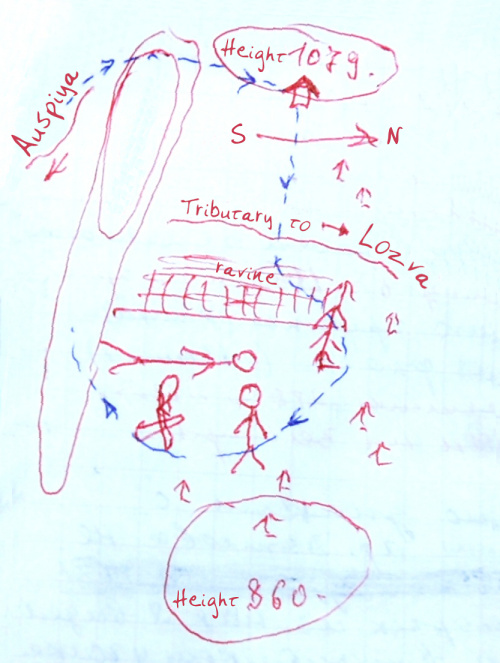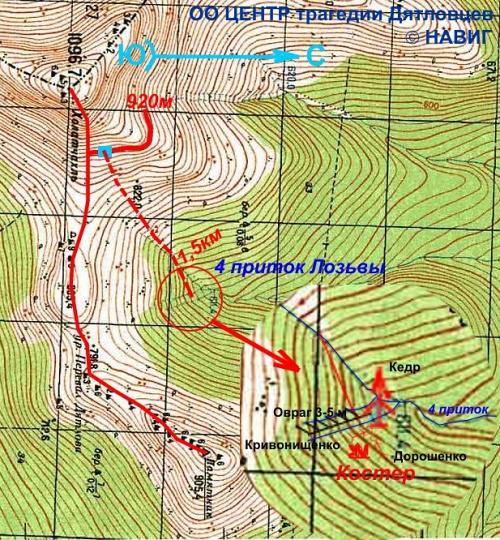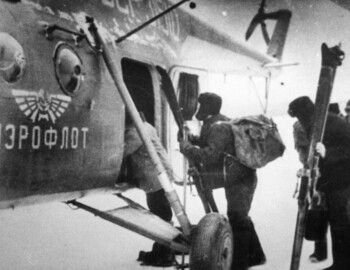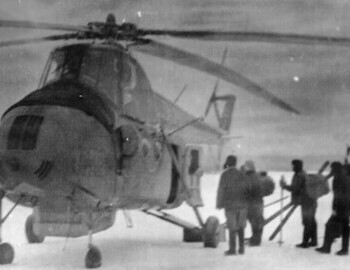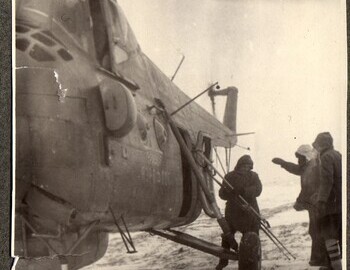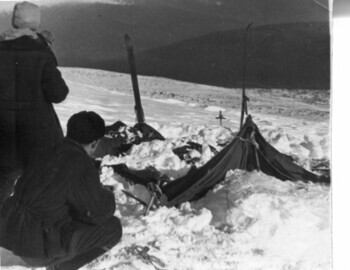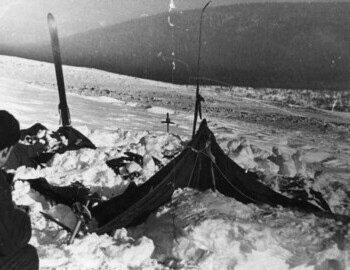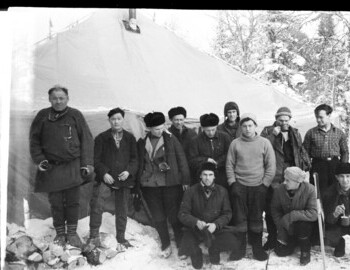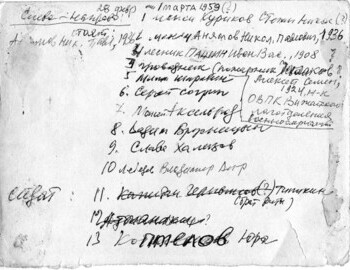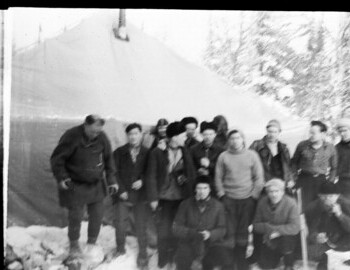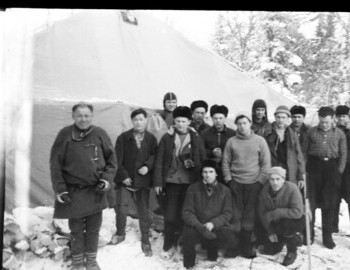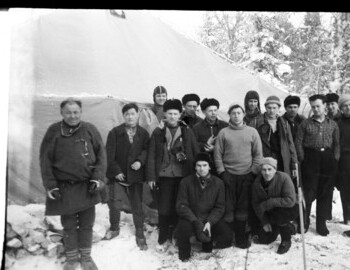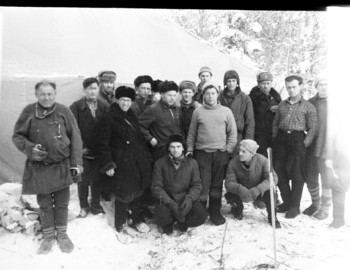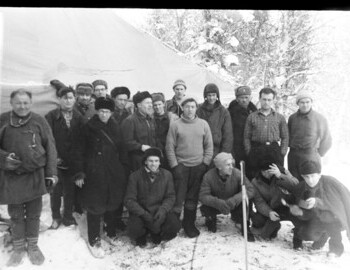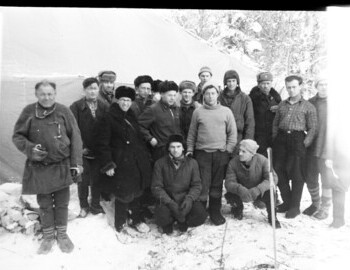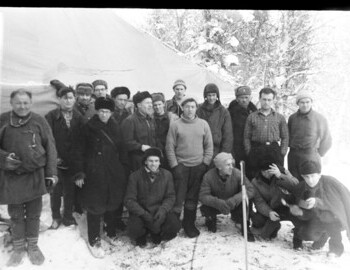
Interview with Koptelov 2008
On the pass with Slobtsov 23.02-4.03 and Martyushev 6-17.04 groups
© NGO "INTERNET CENTER of the Dyatlov group tragedy", 2008
The text of the conversation of the "Center for Civil Investigation of the Dyatlov Pass tragedy", NAVIG (N) with searcher Y.E. Koptelov (YEK) on the case of Dyatlov Pass incident 01 February 2008
Y.Y. Yudin (YY)and V.E. Buyanov (B) were present during the conversation. The copyright for the sound recording and this text belongs to: "INTERNET CENTER of the Dyatlov group tragedy"; Yuri Evtiheevich Koptelov, searcher in 1959. Text recorded and edited by Verden. Sound recording produced by Elder (E). The text was verified using a video recording of the NAVIG conversation.
N: Today is February 1, 2008. We are interviewing a member of the search group, Yuri Evtiheevich Koptelov. Yuri Evtiheevich, tell us everything chronologically, how the events took place and about your participation in them as a member of Slobtsov’s group.
YEK: Somewhere on February 19-20, we heard about the death and that in connection with the decision of the trade union committee and the director of the institute...
N: Sorry to interrupt. From whom did you find out?
YEK: All the time in the previous years I was the leader of weekend treks and therefore hung out between lectures at the club. We had a hikers' corner there. I was hanging out there and naturally the news came out right away. This is in UPI. There, in the area of the construction department, where the trade union committee is, just between the economic and the construction departments, under this wing there was a hikers' corner. And so, somewhere around 19-20 there was a rumor that in connection with the death, that is, they were already assuming that they had died. The group has not been in contact for almost 3-4 weeks and there is a decision to organize a search. I heard this and offered my services. I say, I could also take part, especially since I’m from the city, I have all the equipment, I’m basically ready. Around February 21, the issue of the composition of Slobtsov’s group was discussed there. That it is necessary to send Slobtsov’s group in the same number as Dyatlov’s group was, that is, in the number of nine people. I say that I would gladly join the group, since I knew Slobtsov and I also knew Vadim Brusnitsyn from the group. They told me: The group has been approved already, but we suggest you come tomorrow, on the 22nd, as a reserve, you never know what will happen. I say: Okay, I'll come tomorrow with full equipment. The next day the group is lined up in the right wing, I stand opposite the group with my equipment. The authorities are passing by, including the doctor. For some reason the doctor rejected one friend. And then they said to me: Get in line, you are going to the pass. They checked all the equipment, got on the bus and went to the Uktus airfield. At the airport there was already a plane waiting for us, an AN.
N: Military or civilian?
YEK: Civil, ordinary AN. They loaded us and we flew to Ivdel. We spent the night in Ivdel, right there at the airport.
N: What kind of airfield is there in Ivdel, military or civilian?
YEK: Civil, but in general, there is a common airfield, there is a city on one side. On the other hand, of course, there are camps. That is, both military and civilian units were present there. In the morning they said that they would drop us off by helicopter.
E: Did anyone meet you there?
N: Who met you there?
YEK: Yes, we were met there, but I don’t remember who it was. As I said, there were 9 of us there, we flew in two helicopters, since we couldn’t fit in one helicopter with all the equipment... But Sharavin and Yudin tell me that two more joined us, the "fireman" and Ivan. But I don’t remember and don’t know this, because we could have flown in different helicopters. And although we were on the route together, our group is large, we were stretched thin. Let’s say, I’m at the back of the group, someone is in the middle... And when cutting the ski track, only the top five changed, and for the last ones to take the first position - of course this didn’t happen.
N: Where were you dropped off? Show me on the map.
YEK: Sharavin and I parted ways here. I believed that we were dropped off on a hill, in an open area, close to the forest, about 200 meters away from the forest. Literally this is such a gentle slope, we rolled down 200 meters with our equipment and there we were already met by the group that was the first to arrive.
E: On Otorten? No?
YEK: So Sharavin and I disagreed. He says that we were dropped off on the right slope of Otorten... But I forgot to say another important detail -
YEK: He says that he also flew on the second helicopter, this may well be the case. But he says that when we were dropped off at a point on the eastern slope of Otorten, and that at that time the group that arrived first managed to run to the top of Otorten and had already checked whether Dyatlov’s group reached Otorten. Although I thought that we had not been to Otorten. I believed that we were dropped off literally on a ridge, somewhere close to the confluence where Auspiya enters Lozva. And I still believe that we were dropped off there. And Sharavin says that since no traces of Dyatlov’s group were found there on Otorten, we made a special detour and then went to Auspiya. And I thought that we were walking along Auspiya all the time.
N: Did you know Akselrod?
YEK: I knew Akselrod.
N: According to information, Akselrod’s group was dropped off on Otorten.
YEK: But the fact is that Akselrod’s group was landed either earlier or later.
E: Sharavin says earlier. And that it was Axelrod’s group that ran there to the top.
YEK: Maybe... This is where Sharavin and I have the number one discrepancy. I believe that we were dropped off where the Auspiya merges into Lozva, in an open place, and not on Lozva. And we went down and here we had our first overnight stay.
N: From your group?
YEK: The scouts from our group went and ran in the morning on purpose, let's say they ran two kilometers, checked that there would be open forest there and it would be better. We had only walked some distance when we heard a plane. The plane began to circle above us. We then quickened our pace to reach a clean, more or less open place. And when the plane flew over us, we started firing rockets from a rocket launcher, first, then with hand-held ones, they fired several rockets.
N: What purpose?
YEK: So that he can see us where we are. He guessed where we were, he flew in search of Otorten-Auspiya-Lozva, in this area, but he didn’t know where we were. When the rockets were fired, he then descended lower, "flailed" his wings and flew away. Then we quickened our pace, walked some more, maybe a kilometer and a half, and came to a more or less clear place. The plane appeared again. And here we just realized that he saw us clearly, we had already put out a sign. He then made another circle specifically above us and threw out the canister. This pennant contained a message that a conductor with Mansi was coming for us, with a walkie-talkie, meet them.
N: At that moment there were nine of you, before the arrival of the guide and Mansi?
YEK: The fact of the matter is that this detail differs between us. It turns out that there were nine of us plus these two "unidentified" people. Which I don't remember, but everyone else says they were. I’m saying that I was almost a random person there. I knew practically no one by sight.
N: Did they catch up with you, these ones about whom there was a message in the canister? Mansi and the radio operator?
YEK: After we received the message from the canister that a guide with a walkie-talkie was following us, we began to look for a place where the plane would clearly see us, where there would be water, firewood - a place for the base camp. We walked some more distance and set up a base camp in a good place, literally flat and open. As a result, it turned out that there was a kilometer and a half left from it to the pass. On the same day we spent the night here.
N: Who was the radio operator? Nevolin?
YEK: Yes, Nevolin. And a Mansi named Kurikov. He looked strong.
N: He was also the chairman of the village council there...
YEK: Yes, yes... They said that he volunteered himself, specifically so that there would be no unnecessary questions. And when in the evening we read the diary and discussed everything....
N: Wait a minute, whose diary were you reading?
YEK: Dyatlov's.
N: That is, Slobtsov and Sharavin took the diary there, in the tent?
YEK: They took a diary there, a flask of alcohol...
N: One diary? Group's?
YEK: There seems to be one, I don’t know about the others. I don’t remember if we read the other diaries, but I remember that we read one, the main diary, where each of them wrote a few lines. It ended on the 31st, I think, and that’s it. So, in this Diary I don’t remember the labaz being mentioned. One of my questions is: when was the labaz set up? Why is the labaz not mentioned in the diary? This leads me to believe that the labaz was not placed on the 31st, when the diary was written, but the next day, and it was no longer included in the diary. And since it was delivered the next day, there is a possibility that they went to Otorten and on the way back they were caught by a snowstorm and so on. And therefore, in order not to lose orientation, not to go somewhere to the side, but to return to the labaz, they specially stopped under this mountain, so as not to completely get lost. Because on the 31st it was 24 degrees with wind, every meter of wind gives 1 degree of frost. If the wind adds 10 degrees, it already gives 34 degrees. And if there were 15-20 meters there, then it was already 40 degrees. That is, with that wind, frostbite could have occurred. And plus, if they were late in time... Let's say, why else could they stop at the top? Because if they returned, let’s say from Otorten. I don’t think they walked two kilometers and set up a tent, then it’s unclear.
I assume that they set up a labaz, went to Otorten that day, and on the way back passed through the ridge. On the way back from Otorten, I guess, they found themselves here in the cold, in a snowstorm, and by time it was already getting dark. It was light on the ridge, but lower down, at the level of the forest, it was dark, they could have fallen through, and so they stopped.
N: The fact is that it takes 3 days to go to Otorten. Or how much? There are 16 kilometers.
YEK: Sorry! Half a day! Twelve kilometers.
N: No, well, back and forth...
YEK: 12 kilometers, you do the math.
АК: 12 kilometers, on crust covered snow, there’s no need to break a path there...
YEK: I went with the pioneers. It's 12 kilometers. We walked for 2.5 or 3 hours in one direction.
N: Without skis?
YEK: Why? By ski. I was there in March 1976. We went to the left of Auspiya, what is the river called there, to the south?
N: This one here?
YEK: Along the route we started from there. That is, this ridge, its left part along Auspiya. We walked along this river, crossed it, went around 1079 on the left, and went to Otorten. And from 1079 to Otorten we walked very little. On this day we walked to the devil-knows-where after Otorten. And in our group there were schoolchildren from 5th to 10th grade.
N: Have you been there in the spring?
YEK: We went in March, yes. Therefore, what was 24 kilometers, well 26, worth for Dyatlov’s group? It would be easy for them. Another thing is that on the way back... Well, naturally, if the doctor said that someone there had a broken knee (NAVIG note: A. Startsev) and if someone was injured on these, on the firn, they could get on the stones. When you ride on firn there... I rode on firn there in March 1976 - great, great fun, carries you at high speed, but you choose a clean place. What if the place where the stones fall? Luckily for us, none of us were hurt, not one of the schoolchildren.
But if one of them was injured on firn, then naturally there would be a time delay. Anyone who had an unfortunate slide had to be pulled out of there first, because you can drive down this firn for two kilometers, and if you hit another ravine, it’s not so easy to get out of it...
That is, they could have lost another hour or two on this. Plus it was frosty on the way back; a snowstorm and wind could have caught them. I believe that on the way back, in order not to lose the landmark - the labaz, they stopped. This is my opinion.
N: Well, this is quite likely, because their newspaper was called "Evening Otorten". That is, as if they had gone there. It hung on the wall of the tent. Korotaev said.
N: Let's go back a little. What happened next? Slobtsov and Sharavin came. You were on duty.
YEK: I was on duty. In the evening we listened to everything and read it. I don’t remember any mention of the labaz in the diary. The next day, Sharavin and I were sent to look for traces. Sharavin also says that since it was already known where the tent was, we were given the task of finding a place closer to it to set up a base camp. But I am telling this information only from his words. I believed that our task was to expand the search.
And so he and I came to the tent. We examined everything around the tent. We found that there was a tent standing, and there were literally footprints from it.
N: Approximately how many meters away did they start?
YEK: And straight ahead, here is a platform, maybe 8-10 meters from the tent, a short distance. And immediately the traces begin. Straight, parallel to the foot.
N: How many of these tracks do you remember? (NAVIG note: this phrase is on the video.)
YEK: ...8-9, we counted them right away...
N: That is, one counted 8 and the other 9?
YEK: It’s just that we counted 8 clearly, and 9 - we said that "here there seems to be a trace or something but not very clear".
N: Have you seen them yourself?
YEK: Certainly! We specifically approached and decided when this trace could have been left and why and who could have left it. Why, for example, was it not blown out? And it could not have been blown out because if, say, you stomp it hard, it will harden after that. Or step on something warm. That is, we discussed.
N: Were the tracks recessed or raised?
YEK: There were mostly depressions. Recesses, mostly. That's why we say, either 9 or not. I don’t remember now, maybe some of the tracks were like elevations, but most of the tracks were depressions. And these tracks went in different places in different ways. They walked at some distance, forward, in the direction of the ravine.
N: How many meters further did the tracks go?
YEK: Well, 60 meters, maybe 100. And along this stretch they slowly got lost. We couldn't see them... because after, say, 12-20 meters, the slope was already going down sharply. There the snow was already looser and the tracks began to disappear.
N: Let's go back to the tent again. When you arrived at the tent, what did you see? What did the tent look like? How did it stand? Entrance? Rim? What was at the entrance of the tent?
YEK: I don’t remember such details. What I do remember is the general position of the tent. Slobtsov and Sharavin talked about it when they returned. Therefore, we didn’t touch anything, the tent was inspected, everything was already disturbed. Therefore, the fact that there were skis or poles there, the position is approximately the same as in the photographs, this is approximately how I imagine it.
The entrance, as far as I remember, was towards the Auspiya River.
N: That is, towards the pass?
YEK: Yes, here we have a pass, it’s long, that’s what it is. Here is 1079, and here is the height of 880 - this is the whole pass... Here is the Auspiya River, here, here is 1079. If you take this pass 1079, the tent stood just above the pass. It stood on some elevation, on a slight slope, on some elevation... If you take it a little like this, in this relative position, then the tent stood like that. The entrance was directed - why I say that they possibly came from Otorten - that the entrance of the tent was directed through the pass towards the Auspiya River. That is, this direction seemed to remain to the south. They came, I believe, from the north. And when the tent was torn and they jumped out, the tracks were perpendicular to the tent and went in this direction.
NAVIG note: height 880, measured from old maps. New designation height 905.4
B: That is, down?
YEK: The pass remained here, and they went here. That is, they went to this side of the pass. Why? Because the tent entrance and the cuts were 90 degrees relative to each other. That is, if they initially set up a tent and were knew that they had to go there, that they had a storage shed there, then, having torn the tent apart, they jumped out and lost their orientation by 90 degrees. They may have wanted to run to the storage shed, but they lost their orientation by 90 degrees and went to the wrong side of the pass, but went to this one. That's why, when some of them, Dyatlov, Dubinina, began to return, what was their logic? When they left and did not find the labaz, they began to return to the tent again and from there look for the labaz. When we decided that since the tracks go straight down into the ravine, we will try to walk and see where we will see these tracks. Some meters passed, the tracks slowly began to end. The snow was already deep. First we had go over this one a hollow, then this pass. Here we assumed that it was the bed of a stream, there were bushes on the left and we first walked along the left side. Here the bushes became denser and denser, we decided that it was impossible to pass here at best. We then went to the right, to a more open place, crossed to the other side of the stream, and on the other side of the stream we began to slowly descend further, lower and lower. In the end, descending along this dell, along this dell, we came across a ravine. There was a vertical wall, 5 meters, maybe 7, or maybe even 10 meters. We thought let's climb in and take a look from above. We then climbed up onto it sideways, using steps, and on the left side here, we look, and in front of us the row of bushes was small, we did not break through them, and to the left there was an opening. We went through the passage. And there it was the cedar. There were bushes behind the cedar. We go around the bushes and see two people lying in front of us, their heads facing each other, and the remains of an extinguished fire.
N: What position? How was it in relation to the tent? Were they behind the cedar or in front of the cedar? What kind of vegetation was there, large or not?
Caption under the drawing: "The traces end after 200 meters, but we go in this direction for another 1.5 km and run into a steep cliff. There is a cedar tree on it. We climb up the cliff making steps and go around the cedar on the left. Under the cedar are the remains of a fire and two bodies, barely dressed and barefoot, lying with their heads facing each other. We hurried to the pass to report our find. We did not have time to get up when a helicopter with investigators arrived. Then a second helicopter arrived with soldiers and dogs. I was asked to show the tent. From noon on February 27 and throughout the 28 I helped the soldiers set up a camp. March 1 Misha Sharavin and I went on a free search. We are looking for traces above the cedar at an altitude of 860. We are skiing. On March 2 we transported 5 corpses to the pass...."
YEK: If you take the tent at the top, like this along the front, then right here is the cedar. Understand? Here is such a slope, on the slope there is a flat area, there are bushes here in the front row, there are bushes here, there is a cedar tree here. Here, one is lying like this, with his head here. The second one lies on his head, here between, there is a fire and on the right there is a cedar. I remember that they were in underwear, practically barefoot. The one who was lying with his feet towards us, I noticed that his nose was badly damaged. They were very dark, literally red. I believe that since they were in an open place, during this month they could even get sunburned from the sun. And the nose could be pecked by nutcrackers. That's what I decided then. That they could get tanned from the sun. Maybe something else happened there, they could also turn black from the sun, in an open place, wind, frost. The sun could melt the snow on them, ultraviolet radiation... But the nose was bitten. Then they decided that it was Doroshenko who was lying there. And there, lying across, was Krivonischenko. But I don’t remember that Krivonischenko was lying under the blanket. I didn't see this.
Reconstruction based on Koptelov's drawing, cedar, bodies, fire, and ravine of the 4th tributary to Lozva
N: Haven't seen it or don't remember?
YEK: I don't remember анъоне lying under a blanket. I remember that they were both lying in their underwear. This is the impression I have. Maybe Krivonischenko was partially covered, he seemed to be lying there a little further away. This one was closer. We then passed literally 1-1.5 meters from his feet. We didn’t approach so as not to touch anything there. We just looked and remembered it for ourselves. Since here we had the steep bank of the ravine, so as not to go back down into the ravine, we went around. Here the cliff turned into a slope of the pass. We walked literally 300-400 meters here and heard a helicopter flying over the pass. We hurried to the pass.
We approached the helicopter while it was unloading. The distance was short. They tell me long distances. What are the distances? There, from the base camp where we left, it was 1.5-2 kilometers to the tent. And from the tent to the cedar we immediately realized that it was 1.5 kilometers, maybe a little more. And if, accordingly, from the cedar to the helicopter, then it was no longer 2 kilometers, the distance was also small, because we literally covered it... well, we were naturally on skis, rested.
E: Did you go skiing?
YEK: Of course, skiing, how else would we move there without skis?
E: And there was crust in places.
YEK: There was a crust, but where? On top of the ridge. And what about the ravines we walked through, through open forests, and along the floodplain? What kind of crust is there? There was no crust there.
N: Let's talk about the cedar. Did you examine the cedar? In what condition was it? What did you find there?
YEK: We did not specifically examine him at that moment. We just saw that the branches were broken off high up.
N: Did you come any closer?
YEK: We were only 3 meters from the cedar.
N: Did you notice that the branches were broken off or cut down?
YEK: They were broken off. If they had been cut down, it would be very obvious.
N: To what height?
YEK: The height was quite decent. They tell me that there were so or so many meters... Well, maybe 3 meters, maybe 3.5. I can still somehow imagine it. They tell me that at such a height. No, no higher than 3.5 meters. It was definitely not higher.
N: Where were the broken branches? Haven't you noticed?
YEK: We didn’t see any broken branches anywhere. We saw only the remains of a fire.
N: And the broken branches? Didn't they hang on a cedar?
YEK: Of course not.
N: There is simply information that they were hanging. Some branches seemed to remain hanging on the cedar. You didn't see it? Or don't you remember? Maybe they were lying near the cedar?
YEK: Now I can visualize... Perhaps they were. So, what is the situation? When we approached and walked around the cedar, there were fir trees and pine trees, not tall, but they were taller than us. There was little clearing near the cedar. Perhaps there were some branches, but in the clearing. But we focused our attention not on this, but on the situation: who is lying, how many people are, in what position they are lying. And since the cedar was a clear landmark for us, we just glanced at what was under the cedar, that the cedar at some height was with broken branches - and that’s all. We didn’t have a task to explore.
N: But maybe you’ll suddenly remember something now...
YEK: Perhaps these branches were there. Maybe there was something in the clearing, but since we came and walked along it, and went up there, we only remember this, this state. I remembered it. Misha's recollections are slightly different, but maybe... they could have looked at it from a different angle.
N: What can you say about the presence of dead wood in this area?
YEK: I didn’t see anything anywhere.
N: Maybe covered with snow?
YEK: None of this happened. I'll explain. This was the first half of February 27, in the second half of February 27, after I brought the investigators to the tent and showed that this was the tent, after that they told me: go to the camp. I was setting up an army tent. Then on the second day I again set up the second tent. But on March 1, Misha and I were released on a free search, to rest. And since three more were already found in the ravine during these days, I did not participate there, and Misha, in my opinion, did not participate either. When it was known that three more had been found, they said, while the dogs could not find anything else there, we were released to search. They said, "You explore height 880." This time we went directly almost to the cedar and from this cedar we rose now, continuing the direction tent-cedar to height 880. We even went further height 880. We passed height 880 just like that and from the top of the height we skied through the forest. We made the track ourselves on skis. In this free search, we did not see any traces, no dead wood, nothing. Because we have now been to the cedar for the second time.
N: Now let's go back to the fire. What was the fire like, what kind of wood was in it? At what distance?
YEK: We didn’t look at anything then, no wood. We saw something like this, a little fire, about this big, (NAVIG: shows with his hands a circle with a diameter of 80 cm) it seemed to stand out, dark, black. There is a small pile of burnt branches on it. About a meter, even less, probably half a meter, two people were lying from the fire. We didn't approach, we didn't touch. Our job was to observe and quickly report that we had found the first bodies. We were not given the task of examining, we were given the task of finding, marking...
N: No, well, the task is a task, but you saw it yourself... Now what can you say, according to your memories?
YEK: That's what I remember, that's what I'm telling. Fire, flat ground...
N: Were there any tracks around the cedar? Were there any foreign objects lying around?
YEK: No, there were no traces, there was nothing. The fact is that a month has passed. It was all covered with snow. By the way, there was a little bit of snow. The corpses were only powdered, well, literally, as if just now there was a breath of air that dusted them with snow, and that’s all. They lay practically uncovered. If you lie down on the ground you will get powdered like they were right away, and that’s all. That's how they lay.
N: Was the fire behind the cedar tree in relation to the tent?
YEK: Let me explain again. Here's the tent. Here we are perpendicular to the entrance, from this cut, here is the cut, this is the slope of the tent. As soon as we started walking, we walked straight perpendicular. We came to a cliff, here it is a cliff. There is a platform on the cliff. There it stands, cedar. We approached a cliff, and along the edge of the cliff there was light forest. To avoid breaking through the open forest, there was a small passage. So, here is the cedar. We went through this passage around the cedar tree. is it clear where the cedar is? On the edge of a cliff. This cliff is parallel to the tent.
N: How far from the cliff was the cedar?
YEK: Just a little. 7 meters not more. And the fire... a meter and a half to two meters away, the first body lay, and half a meter away was the fire.
B: Between them, right? Between the cedar and the dead?
YEK: Between the cedar and the deceased there was a meter and a half, well, two.
B: Was the fire near the cedar or on the other side of the dead?
YEK: There was a fire - Doroshenko was lying closer to the cedar, with his back to the cedar, on his back or not on his back... Here is the cedar. This is how Doroshenko lay, this is how Krivonischenko lay. They lay with their heads facing each other.
B: Was there a fire between them?
YEK: (Drawing) Here is a cedar. Here they lay, and here is the fire. (Continue to draw all the way from the tent again)
N: Was there a stream here? Why did the cliff form?
YEK: Well, naturally. The main stream is from here. This is a tributary of the Lozva. And here is Lozva. And this is Otorten already.
B: Somehow they both lay along the fire.
YEK: They lay not lengthwise, but with their heads facing each other. Just like that, they lay there. But that's okay, because they were both warming themselves by the fire.
N: I don’t understand this picture. Because according to the map it’s different there. Can I have a sheet? I'll draw it like on a map.
YEK: Here, look at the map. I repeat what is drawn there.
N: According to the map it looks like this. If this ridge goes... Belt stone.
YEK: Do you mean the Ural Range?
N: Yes, the Ural ridge. Here is Auspiya, here is height 1079, here is a spur, here is 880, here is 905 (Note NAVIG. New designation of heights). And here comes the Lozva, it goes far, and here are the tributaries -1, 2, 3, 4... So, the tent was here, they ran down and the cedar was here. And from the cedar to the ravine where the last ones were found was 50-70 meters.
YEK: I’ll explain. This is the river. We will continue the slope, we found it in this area, right here there are 70 meters. That's where they found, below, the last four.
N: No, wait. What, when they were running, did they climb up the cliff to the cedar?
YEK: Well, how could it be otherwise? Their path was blocked by a ravine.
N: Their path was blocked by a ravine 5 meters high? We did not have such information.
B: We went around. You bypassed, right?
YEK: No, we didn’t bypass. We just climbed up, we climbed up a ladder, not like we ski, but sideways, on skis.
B: Well, they don’t have skis.
YEK: There the slope was 70-80 degrees.
N: Was the ravine blocking your path?
YEK: Of course. We ran into it. But we look, there is a height, some kind of observation deck, we went out to it - and just went out to the cedar tree and went out to the fire.
N: Was the ravine heavily filled with snow? Why couldn’t they find these right away? Or was it deep?
YEK: Imagine, here we had 3, 5 or even 7 meters, so I remember. Well, the height was definitely 3-4 meters. Well, imagine, if this is a real ravine, that means there are still 3-4 meters below us. Do you agree? What if another 70 meters to the side? This means there is even more depth. If the wind always blew only in this direction, through the mountains. I was there in 1976 as well. The wind was blowing in only one direction. And here the altitude is already 880, there is already a forest here and therefore all the snow lingered. And so, naturally, the ravine was leveled.
N: And the difference was still 5 meters?
YEK: It was definitely 3-4 meters. Maybe even more, because we didn’t overcome it so easily.
N: I have not heard such information before.
YEK: I’m saying, you don’t just go up a hill, ski forward, but we climbed up sideways. That is, we deliberately made steps and use them to climb up with the skis.
N: So you didn’t find any traces here?
YEK: And everything there was covered with snow.
N: It says in th case files that a handkerchief was burnt, money was lying around...
YEK: This all was found later. Then everything was sorted out by those who were supposed to do it.
N: You had no time.
YEK: Our task was different - to find and report. But it wasn’t our job to figure it out. We could have messed it up, and then we would have wondered where it came from?
N: By the way, did you have an assignment from the prosecutor’s office so as not to disturb anything or did you know this yourself?
YEK: We didn’t have any task, or instructions at the begining.
N: So the UPI sent you and no investigator spoke to you?
YEK: No, we had a task...
B: There was some kind of briefing, right?
YEK: None. The goal was simple: we are sending you from UPI, your goal is to find, if possible, and report. That's how it was roughly...
YY: Well, "you’ve done your job and don’t interfere anymore". Everyone had that meaning there.
YEK: Nothing like that was said directly.
N: And the radio operator, at whose orders was he? You reported back to Slobtsov, right?
YEK: We did not have a radio operator at our disposal.
N: Was he on his own?
YEK: Of course, on his own.
N: What did he radio? Did he have a microphone?
YEK: I don’t remember, because Slobtsov was in charge.
N: So he himself radioed something? And Slobtsov fed him information, for example, "we found this and that"?
YEK: Something like that. I don't know. I have already said that I was the "fifth wheel in the cart" there, so they did not report to me. As I said, we didn’t have any instructions "do this, don’t do that". Nothing was said either on the bus or at the UPI. I don't remember anyone telling us anything. On the bus they might have said something to Slobtsov, or to someone else. I don't remember.
YY: So they didn’t say anything to anyone directly?
YEK: They didn't say anything. We flew on the plane later, we flew in the helicopter, they dropped us out - there were no conversations, none of this happened. Information? When they sent us they said: there is a tent over there, we need you to search further. If possible, choose a place for a new base camp, closer to the tent. That's the whole conversation with us.
N: Okay. What did you do next when you returned from the cedar?
YEK: When the helicopter with the authorities landed, we approached the helicopter, the authorities poured out. We reported. As far as I remember and imagine, I was asked to show where the tent was. I don’t know whether Misha was at the tent again or not. I went to show them. Yes, there, I say, is a tent, it’s not far, you can see it. Well, show me closer, they say.
N: You mean, the hikers' tent? Because yours was also there.
YEK: Yes, Dyatlov’s tent. I said: "there’s the tent, near". And they: "Well, show us, you were there, but we haven’t." I said: "Well, let’s go, I’ll show you." I showed me the tent. After that they tell me: "that’s all, you can go now." Well, I returned to the pass. I just started descending from the pass, and here things were already lying around, a path was cleared, the ski track was well visible. I went along this ski track. Things were laying on left and right. The soldiers’ belongings were here... Well, when I approached, they said: "help put up a tent for the soldiers." I say: "What about our camp, and my things?" Some of my things still remained in the camp.
They tell me: "They’re already picking up your things, and they’ve already found the labaz.” And I went to help set up the tent. We all spent the night in this tent. And the next day, as far as I remember, they asked me again to put up a second tent, there were so many people, and so that the authorities and officers were in one tent, so that they could discuss matters, and the soldiers could rest peacefully in another tent. I say: "Okay, I'll help." "At the same time, tell me where do you get water, firewood, where can we make a toilet?" So here I was, working with the second tent for almost the entire second day. But on the third day, Misha and I went to the tent again and explored height 880. And that’s it. And already on March 2 we were busy delivering corpses to the pass.
The five people who were found. At the pass, they said, there will be a helicopter that will pick up the corpses and take us back. The helicopter arrived and took all the corpses, but they didn’t take us that day. We flew out the next day.
N: You flew away and never went back?
YEK: Yes, we were already in Sverdlovsk on March 5th. I returned on the pass again with the second search again. This was around the end of March. There they were already searching the snow with long poles.
N: Didn't they find anything while you were there?
YEK: No, we did not. They found the remaning later.
N: That is, you haven’t seen those four.
YEK: No, I didn’t see them.
N: Well then, a question about the diary. You said you read the diary. Where did they put it then?
YEK: All questions about the diary are for Slobtsov, because he took it, he gave it away. To whom, I don’t know.
N: Who gave you all the orders up there? Who said: "Take me to the tent?" Who commanded all this?
YEK: I don’t remember now. I didn’t know practically anyone.
N: What uniform did they have? Military, civilian?
YEK: Civil. It is quite possible, as they say, that Chernyshev was in the first helicopter. Ivanov, Korotaev, which helicopter were they in? Between the first helicopter and the second, as far as I remember, there was a difference of only 15 minutes. Maybe a little more. Because when we climbed the pass, the first helicopter was already unloading, and when we approached it while it was unloading, the second helicopter was already flying in. It landed nearby, a couple of hundred meters from the first one. Right before our eyes. Apparently they were flying one after another.
B: You didn't know who arrived?
YEK: How could we know this? We are strangers, they are strangers. Moreover, I didn’t know anyone there.
YY: Did you know me?
YEK: I knew you, but you weren’t there.
B: Didn’t you know Grebennikov’s group?
YEK: I didn’t. I could know many people, including the Dyatlov group, only by sight. Personally, I only knew Slobtsov and Brusnitsyn. I was the little guy there, a weekend trek leader, an activist.
B: What course were you on then?
YEK: Fourth. But the masters didn’t go on weekend treks, only beginners, who had to be monitored so that they didn’t take extra steps left and right. No, well, of course, when there were conversations there, let’s say "Korotaev" or "Ivanov", I knew who they were, but I didn’t know them personally.
YEK: On February 27 in the second half and on the 28th I was doing chores and I didn’t know what was happening there at the pass.
B: Did you see the dogs on the 27th?
YEK: No, I'm telling you. When the first helicopter arrived, I didn’t even get to the second one. They asked me to show the tent, and I did. And then - "Brownian motion", I don’t even know which of the members of our group was where. I don’t even know where Sharavin was. Everyone was given a task and everyone did it.
YY: Sharavin, he is a tracker and hunter. Therefore, his perception is more targeted.
YEK: That's not the question. We were not given any special tasks. He was closer to Slobtsov, they could have discussed something that I didn’t know. Maybe they discussed it before, maybe along the way. Maybe when the tent was found. Maybe they discussed all these issues. I do not know that. I only talk about my memories.
B: Do you remember the thickness of the snow in the cedar area?
YEK: The thickness of the snow there cannot be correctly assessed. I say that there was a clearing, and by the height of the trees it was difficult to determine how tall they were, and therefore the depth of the snow. But the area that we found and where the fire was, is flat and slightly covered with snow. Therefore, it is impossible to estimate the thickness of the snow. How can you estimate the thickness of the snow underneath you? No way. The area is flat. (end of recording)
N: Thank you.
The only photos with Koptelov
Koptelov is hardly in any photos. You can see him in the base camp photo session with a mug and spoon at the far right. He likes to squat maybe because he is usually the tallest in the group. Yuri Koptelov calls himself "the fifth wheel", he didn't know anyone and no one remembered to warn him what not to do or say, no one remembered to question him since he and Mihail Sharavin found the bodies and Sharavin was hospitalized after a ski incident when the testimonies were taken. It is almost as if Koptelov was never there, and his account of events is almost as if he is talking about a different cedar and the position of the bodies is different, and he says he loaded 5 bodies in the helicopter before the fifth body (Slobodin) was found. What gives?

